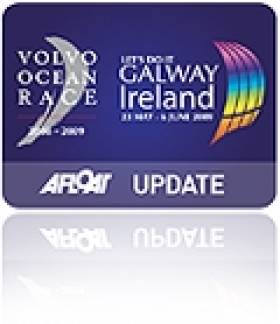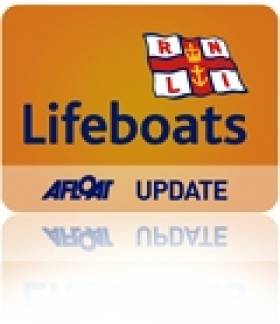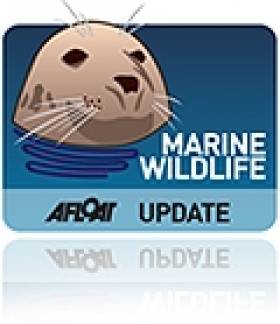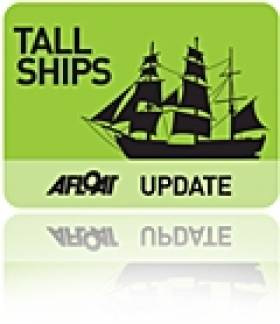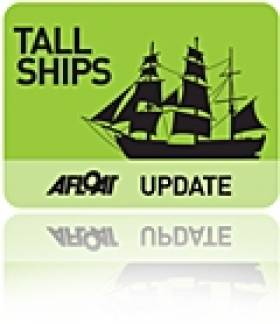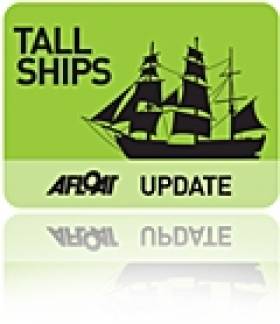Displaying items by tag: Waterford
IWDG Secures 75% Funding for Celtic Mist Refit
#TALL SHIPS - The Irish Whale and Dolphin Group (IWDG) has secured three-quarters of the funding it required to refit its research vessel Celtic Mist.
According to The Irish Times, the Clare Local Development Company has approved the allocation of a €48,000 grant towards the refurbishment of the ketch.
The work will be carried out by Cathal Blunnie and several sub-contractors, and involves stripping down the main cabin and removing the bath and shower to increase space for crew berths.
While the ship's clock will be retained, the ship’s wheel in the main cabin will be removed and presented to the Haughey family as a gesture of appreciation.
As previously reported on Afloat.ie, the 52-foot yacht - which was gifted by the Haughey family to the IWDG to assist in its marine wildlife conservation work - entered dry dock last November in preparation for the refit work, after relocating to its new berth at Kilrush, Co Clare in July.
This followed its last jaunt at sea in its former guise, completing a leg of the Tall Ships Races from Waterford to Greenock in Scotland.
The cost of refurbishing the yacht for research and training purposes is expected to top €60,000, with an annual running cost of some €20,000, for which the IWDG is seeking ongoing financial assistance.
The group aims to get the Celtic Mist back at sea before the summer.
Volvo Ocean Race in Galway Will See Irish Food in Focus
#VOLVO OCEAN RACE - Top chef Maurice Keller was in Abu Dhabi last week to fly the flag for Irish food at the third stopover of the Volvo Ocean Race, Waterford Today reports.
Keller spent a few days away from Waterford's Arlington Lodge to join members of Good Food Ireland, Tourism Ireland and Irish embassy staff for a special 'Ireland Day' at the VOR Village.
The initiative was designed to promote Ireland as a prime tourist destination ahead of this summer's Volvo Ocean Race visit to Galway.
And food will play a major role in efforts to attract visitors to the finish line in Galway this July, according to the Limerick Post.
Foodies from across the mid-west will converge at a 'Foodie Forum' at the Galway-Mayo Institute of Technology on 2 Feburary, where plans to showcase Irish food in the city will be top of the agenda.
“At the launch of the countdown to the Volvo Ocean Race, the Let's Do It Galway team announced the four main pillars of the race next summer – marine, green, innovation and food," said Cáit Noone, head of the Hotel School at GMIT.
"The food pillar will provide Ireland with a global showcase opportunity to share with the world our food experiences and the outstanding locally sourced produce we have to offer.”
Fin Whales Could Be Wexford Bound
#MARINE WILDLIFE - The Enniscorthy Guardian reports that the fin whales that have been sighted off Tramore in recent weeks may soon make their way towards the Wexford coast.
Afloat.ie recently reported that Waterford was the 'best place to be' for whale watching, with the Irish Whale and Dolphin Group (IWDG) confirming fin whale sightings along a 20-mile stretch from Stradbally to Brownstone Head.
Cetacean fans are being advised to keep an eye on the coast from Hook Head to Brownstown headland to catch a glimpse of the fins, which are renowned for their six-foot whale blow.
Whale watchers are also urged to report any sightings to the IWDG online at www.iwdg.ie to help keep its database up to date.
Ballycotton Lifeboat Launched to Assist Ailing Fishing Vessel
#LIFEBOATS - Ballycotton's RNLI lifeboat was dispatched in poor conditions Wednesday evening to fishing boat taking on water some 20 miles south east of the Co Cork town, FishNewsEU.com reports.
Assisted by the Waterford coastguard helicopter Rescue 117, the lifeboat stood by the Irish-registered fishing vessel as its four-man crew kept the water intake under control and headed towards Ballycotton harbour under its own power.
Once returned to port, an RNLI salvage pump was placed aboard the boat to extract the excess water, and the crew offered thanks to the emergency services for their assistance.
Waterfront Development Opportunities in Northern Ireland, Waterford
#WATERFRONT PROPERTY - A number of prime waterside development opportunities are up for grabs in Northern Ireland and Waterford.
North of the border, Northern Ireland Electricity (NIE) is currently seeking expressions of interest for three sites.
The first of these, in Belfast, is the site of the former Belfast West Power Station. The 16-acre site on McCaughey Road, close to the city centre, is currently zoned as employment/industry.
Further north on the shores of Belfast Lough is a 45-acre whiteland site adjacent to Kilroot Power Station in Carrickfergus. Both Kilroot and Belfast West will be available for lease only due to their strategic nature.
Also available are lands adjacent to Coolkeeragh Power Station, near Derry and the mouth of the Foyle. This 28-acre site is zoned as existing industry.
All three sites are restricted to generation or other electricity industry uses.
The closing date for expressions of interest is 12 noon on 20 February 2012. For more contact Savills Belfast at +44 (0) 28 9026 7820 or [email protected].
Meanwhile, in Waterford, estage agent Purcell Properties is guiding €1.5 million for an 18-acre landbank with extensive frontage on the Suir, less than a mile from the city centre.
The site at Newrath, previously used by Smurfit for plastic production, comprises mixed warehousing developed around 50 years ago.
The landbank is close to the new bridge connecting with the Waterford-Dublin motorway. Zoning of the site would allow mixed use including retail, light industrial and warehousing.
For more details contact Purcell Properties at 051 876 514 or [email protected].
Waterford Tall Ships Win People of the Year Award
Tall Ships Festival Waterford 2011 received a People of the Year Award at the ceremony at Citywest hotel on Saturday for the enormous voluntary and community effort which led to a hugely successful festival. The event, with the support of organisations in the public and private sectors, saw a fleet of 50 ships sail into Waterford Quays, and a festival of culture, craft and cuisine was put on to celebrate.
A number of cultural venues held a range of educational events and exhibitions, while top names in local, national and international music played across the city. An estimated 500,000 people visited over the course of the festival and it is estimated that the event generated some €30 million in economic activity for the region.
However, this could not have happened without the more than 500 volunteers who stepped forward to offer support, taking great pride in their home county and its nautical heritage. The award was accepted by Des Whelan, Chairman, Tall Ships Festival Waterford 2011 and Cllr Pat Hayes, Mayor of Waterford, and presented by Angela Kerins, Chief Executive of Rehab and Chairperson of the Adjudication Committee.
Celtic Mist Will Track Elusive Blue Whale
The infamous Celtic Mist is set to be used to track one of the most elusive marine animals in Irish waters.
The Irish Examiner reports that one of the first duties of the yacht under its new ownership by the Irish Whale and Dolphin Group (IWDG) will be to track down the blue whale, the last of which was spotted off the Irish coast in 2009.
"We’ve made two sightings of the blue whale on the shelf edge but with the Celtic Mist we will be able to go out there for a few weeks and sit there and wait for them," said the IWDG's Dr Simon Berrow.
"Hopefully we will find some more when we bring the Celtic Mist out there. They are very rare."
The blue whale is regarded as the largest animal to have ever lived on earth. They also have an average lifespan of well over 100 years.
As previously reported by Afloat.ie, Celtic Mist was gifted by the Haughey family to the IWDG earlier this year to assist in its marine conservation work.
The yacht competed in a leg of the 2011 Tall Ships Race from Waterford to Scotland before moving to its new home in Co Clare, where it will be refitted for its new life as a research vessel.
US Cutter Eagle Returns to Home Port After Europe Voyage
The US Coast Guard's training barque Eagle returned to her home port of New London, Connecticut last week after a summer-long voyage to Europe.
Last May the ship and its crew paid a visit to Waterford ahead of this year's Tall Ships Races, where it met a contingent of Connecticut residents, before sailing on towards Hanover, Germany where she was first constructed 75 years ago.
Other ports of call included London, Reykjavik, Halifax in Nova Scotia and a final stop in New York City.
"The cadets had an incredible chance to sail the Atlantic as it was meant to be sailed," Captain Eric Jones told Connecticut's The Day.
The captain noted that it was also a voyage of remembrance, referencing the history of the ship - which the US received in reparations after the Second World War - and the laying of a wreath to memorialise the Coast Guard cutter Alexander Hamilton, torpedoed by a German U-boat off the Icelandic coast in January 1942.
The Day has much more on the story HERE.
Celtic Mist Berths at New Home in Co Clare
The Celtic Mist sailed to its new berth at Kilrush in Co Clare on Saturday to begin its new life as a marine research vessel.
As previously reported on Afloat.ie, the 52-foot yacht was gifted by the Haughey family to the Irish Whale and Dolphin Group (IWDG) to assist in its conservation work.
It also recently completed a leg of the Tall Ships Races from Waterford to Greenock in western Scotland - the only Irish entry to compete in the race this year.
According to Irish Weather Online, the yacht will be used for research and surveying of whales, dolphins and other marine wildlife in Ireland, as well as training people to carry out marine surveys by acoustic monitoring.
Irish Weather Online also has images of the Celtic Mist arriving at its new home HERE.
Tall Ships Videos from Waterford
There's been a range of videos coming into Afloat.ie following the Tall Ships visit to Waterford on the 30th June 201.
Below is a short observational documentary shot on The Tall Ships Race. The piece was shot on a Canon 550d camera with a soundtrack from Irish singer/songwriter Cathy Davey "Sing For Your Supper".
Parade of Sail from Waterford, Ireland for the start of the 2011 Tall Ships Race. Place: Passage East, early morning, 3 July, 2011. Photography by Mik Herman.
And some footage of shoreside festivities by Fionn




























